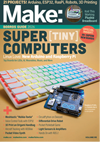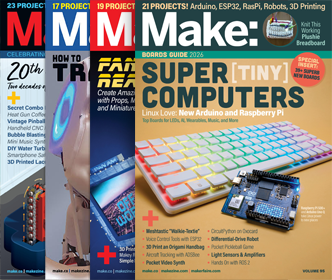

One of my favorite ham radio activities is making contacts on satellites. It’s really fun to know that you’re controlling something that’s receiving and sending communications from space. But communicating with satellites means carrying a big Yagi antenna around. So, I decided to use my fashion sewing skills to make a collapsible fabric Yagi antenna that’s much easier to transport.
You can only transmit radio if you have a ham radio license, but you can listen to communications on satellites without a license. If you don’t have a license, you only need to build the receiving part of the antenna. You can read all about how to listen to satellites in my previous post, “Catching satellites on ham radio“.
This antenna design is based on one by Kent Britain WA5VJB [PDF link].
Materials
[A] Brass rod (6′) (1/8″ diameter)
[B] Hollow large brass/bronze rod (9′) (1/4″ diameter)
[C] Hollow small brass/bronze rod (1′ ) (3/16″ diameter) Make sure the small brass rod slides snuggly into the large brass rod.
[D] Elastic string (3 yards)
[E] Buckles (2) That fit narrow strapping
[F] Round buttons with thread shanks (4) You can also use a pony bead, or a button with a big shank but these will not look as nice.
[G] Velcro ties (2)
[H] Thread To match strapping and fabric
[I] Narrow strapping (1 yard ) (3/4″ wide)
[J] Wide strapping (2 Yards ) (1-1/4″ – 1″ wide) Like the bottom adjustable parts of straps on a backpack.
[K] Heavy fabric (1 Yard ) I’m using a heavy nylon canvas, a fabric used to make bags. You could also use oil cloth or vinyl. Choose a heavy and durable fabric. Like the type that laptop bags or suitcases are made out of.
[L] RG-58 coaxial (10′) With BNC or UHF connectors.
[M] Wooden meter stick (1) Or a 1/4″ x 1 x 2ft. piece of wood.
Adhesive Velcro (1′)
Masking tape
Tools
Heat Gun
Soldering Iron
Vice
Hacksaw
Pliers
Scissors
Sewing Machine
Pins
Tapestry Needle
Hand sewing Needle
File
Directions
Fabric antenna
Step 1: Cut the fabric to make a 24″ x 24″ square.
Step 2: Cut the wide strapping to make one 24″ piece and one 12-1/2″ piece.
Step 3: Cut the narrow strapping to make two 16″ pieces and finish the ends with a heat gun.
Step 4: Melt all of the strap ends with a heat gun to keep them from fraying.
Step 5: Thread one end of each narrow strap through the female end of the buckle. Bend the end back 1″ and sew in place using sewing machine. Use a running stitch. Backstitch a couple of times so that you’re sewing back and forth over the same spot to secure the stitches.
Step 6: Pin the 24″ wide strap from step 2 to mark where the antenna elements will go. Pin at 6″, 13″, 16″, 18-1/2″, and 21-1/2″.
Step 7: Tape the wide 24″ strap to the center of the fabric to secure it in place while you’re sewing. Use the image above as a guide while sewing.
Step 8: Start sewing by each of the pins. Use a running stitch to sew a line across the strapping 1/4″ below each pin. Make sure to backstitch at the beginning and end of each line so the stitch lines are extra secure.
Step 9: Remove the pins. At 6″ and 13″ sew a second line that is 1/2″ above the first line.
Step 10: At 16″, 18-1/2″, and 21-1/2″ sew a second line that’s 3/8″ above the first line.
Step 11: Slide the Velcro ties under the strapping as indicated in the image and secure them with tape.
Step 12: Sew along the edge of the strapping, making sure not to sew over the gaps you have created in steps 9 and 10. You will be sewing the same rectangle pattern as the yellow squares.
Step 13: The 12-1/2″ wide strapping will become the handle. Position the handle 1-1/2″ from the bottom (handle side) of the fabric. The sides of the strap should each be 6″ from the center of the fabric so that a gap is formed between the handle and the fabric. The handle will lay right on top of the wooden rod.
Step 14: Place the buckles under the sides of the strap and tape everything in place.
Step 15: With the sewing machine, sew 3″ rectangles as indicated by the yellow lines in the image above.
Receiving elements
Step 16: With your hacksaw, cut 1/8″ brass rod to be 12-1/5″ and 13-1/2″. These will be the elements for the receiving antenna. You may wish to file the ends to make them smooth.
Step 17: Create the driven element by cutting 1/8″ brass rod (about 21″) and bending it to the dimensions in the photo above. You can use a vise and 1″ diameter pole like a broom handle to help you.
Step 18: Cut the coax cable in half.
Step 19: Strip 2″ of the outer insulation off one end of the coax cable, being careful not the cut the wires inside. Separate the wires and twist them to the side.
Step 20: Strip 1″ of insulation off of the inner wire.
Step 21: Connect the coax cable to the driven element. Wrap the insulated inner wire around the short part of the “J” and the twisted outer wires around the long part of the “J.” Solder the coax cable to the driven element about 1-1/4″ away from the short end of the “J.”
Transmitting elements
If you’re only building the receiving part of the antenna, skip to Step 40.
Step 22: Make one element (the reflector) by cutting the large hollow rod to be 19″ and 21-1/2″. Cut a 2″ piece of small hollow rod. If you do not have enough brass/bronze rod, you could also use aluminum, like I did.
Step 23: Slide the 2″ small rod halfway into the 19″ large rod. Pinch the end with a pair of pliers to secure the small rod in the large rod.
Step 24: Using the small hand sewing needle, sew a 25″ piece of thread to one end of the elastic. Tie the other end of the thread to the large tapestry needle.
Step 25: Slide the 21-1/2″ rod over the other side of the small rod. Temporarily secure the rods together with tape. Do NOT crimp with pliers.
Step 26: Drop the tapestry needle down into the hollow rods. Pull the needle out of the bottom and pull the elastic through the rods.
Step 27: Make the driven element by cutting the large hollow rod to be 20″ and 39-1/4″. If your rod is not long enough, you can easily join two pieces of large hollow rod together. Cut a 1″ piece of small hollow rod. Slide the 1″ small rod halfway into the large hollow rod. Slide the other piece of large hollow rod over the other side of the small hollow rod. Solder the joint.
Step 28: Using the method from Step 25 and 27, thread a piece of elastic through the 39-1/4″ rod. Make sure the have about 3′ of extra elastic at the end.
Step29: Bend the 39-1/4″ rod to the dimension in the photo.
Step 30: Repeat steps 20-21 on the other piece of coax cable.
Step 31: Connect the coax cable to the driven element. Wrap the insulated inner wires around the longer side of the element. Wrap the twisted outer wires around the shorter side of the element. Solder the coax cable close to the edge of the shorter side of the element.
Step 32: Cut a 2″ piece of small hollow rod. Slide it halfway into the 20″ rod and pinch the end with a pair of pliers to secure the small rod in the large rod.
Step 33: Using the method from Step 25 and 27, thread the elastic from the short end of the 39-1/4″ rod through the small side of the 20″ rod.
Assemble the antenna
Step 34: Slide the 19″ reflector element piece from Step 24 through the slot from Pin 13″. Slide the 20″ driven element piece from step 33 through the slot from Pin 6″. Slide both pieces so that a 1/4″ of the large hollow rod extends to beyond the left side of the strapping.
Step 35: Connect the 39-1/4″ driven element piece and the 20″ driven element piece by sliding the large hollow rod over the small hollow rod. Connect the 21-1/2″ reflector element piece to the 19″ reflector element piece.
Step 36: Tie the elastic from one side of the reflector element (the rod on the bottom) to the shank of the button. Cut off the extra elastic.
Step 37: On the other side of the reflector element thread the button on the elastic. Pull the elastic as tight as possible and knot the elastic to the button. Cut off the extra elastic. When you let go of the button, the thread shank should be pulled into the hollow rod.
Step 38: Repeat Steps 37 and 38 for the reflector element.
Step 39: Add the receiver elements to the antenna. Slide the 13-1/2″ rod through the Pin 16″ slot, slide the driven element through the pin 18-1/2″ slot, and slide the 12-1/5″ element through the Pin 21-1/2″ slot.
Step 40: Using the hacksaw, cut the meter stick to 23″.
Step 41: Turn the fabric antenna over. Connect the meter stick to the center of the fabric antenna with adhesive Velcro. Try to stick the Velcro to the raised parts of the fabric where the elements are. The hook side of the Velcro should go on the meter stick.
Step 43: Remove the meter stick and turn the fabric antenna over. Adhere Velcro so that you can stick the meter stick 1-1/2″ above the bottom of the antenna.
To collapse the antenna: Collapse the transmitting element pieces by pulling them apart. Slide the collapsed transmitting elements to the center. Coil the coax cable and fasten them with the Velcro ties. Roll the antenna from top to bottom, and clip together.
To assemble the antenna: Unroll the antenna. Uncoil the coax cable. Connect the transmitting element pieces and slide them over so they’re centered. Remove the meter stick. Flip the antenna over, and stick the meter stick in the center. Roll both ends of the fabric to the center. Fasten the Velcro ties. Rotate the driven elements and slide them toward the center so that the short part of the “J” is under the roll of the antenna. Secure the coax cable with the Velcro ties.
ADVERTISEMENT






